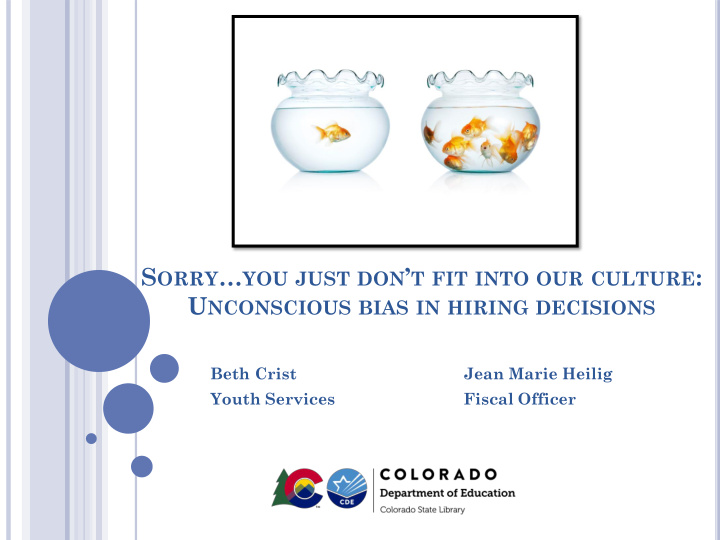



S ORRY … YOU JUST DON ’ T FIT INTO OUR CULTURE : U NCONSCIOUS BIAS IN HIRING DECISIONS Beth Crist Jean Marie Heilig Youth Services Fiscal Officer
“If you have a brain you’re biased” -Dr. Heidi Grant NeuroLeadership Institute
• Explicit Bias • Implicit / Unconscious
W HERE DO THESE BIASES COME FROM ? Direct Experiences (with other people, events, situations) Vicarious Experiences (those relayed to us through other people, stories, books, movies, media and culture)
L IBRARY W ORKERS : F ACTS AND F IGURES
A DDRESSING THE E LEPHANT IN THE ROOM Male 21% Female 79% https://www.dpeaflcio.org/factsheets/library-professionals-facts-and-figures?rq=LIbrarians
Asian-American or Pacific Islander Hispanic or Latino 4.6% 8.6% Black or African American 6.8% White, non-Hispanic 77.0% https://www.dpeaflcio.org/factsheets/library-professionals-facts-and-figures?rq=LIbrarians
Library Professionals Mean Annual Earnings $59,795 Librarians $51,715 $38,676 Library Technicians $30,874 $31,665 Library Assistants $27,740 $0 $10,000 $20,000 $30,000 $40,000 $50,000 $60,000 $70,000 Men Women https://www.dpeaflcio.org/factsheets/library-professionals-facts-and-figures?rq=LIbrarians
What biases can affect the hiring process?
U NCONSCIOUS B IAS B EHAVIORS Gender Bias https://www.youtube.com/watch?v=7nJq6des4jg
U NCONSCIOUS B IAS B EHAVIORS Confirmation Bias
U NCONSCIOUS B IAS B EHAVIORS Beauty Bias
U NCONSCIOUS B IAS B EHAVIORS Halo Effect
U NCONSCIOUS B IAS B EHAVIORS Horns Effect
U NCONSCIOUS B IAS B EHAVIORS Leniency Bias
U NCONSCIOUS B IAS B EHAVIORS Strictness or Stringent Bias
U NCONSCIOUS B IAS B EHAVIORS Compare and Contrast Effect
U NCONSCIOUS B IAS B EHAVIORS Personal Similarity Bias or Affinity Bias
U NCONSCIOUS B IAS B EHAVIORS Conformity Bias
R ECRUITMENT : R EASSESS N EEDS What are the critical outcomes of the position? Are “traditional” experience and education requirements necessary? What skills can be learned on the job?
J OB D ESCRIPTIONS Focus on essential skills and outcomes required over specific experience and education Avoid jargon/abbreviations Use inclusive, neutral language
J OB D ESCRIPTIONS Masculine Terms Feminine Terms Confident Cooperative Driven Supportive Rock Star Dependable Ninja Collaborative Leader Interpersonal Skills Decisive Honest Adventurous Understanding
J OB D ESCRIPTION A CTIVITY
J OB P OSTINGS Advertise within and beyond traditional library job outlets Ask community partners to advertise openings Assign a contact(s) who can provide assistance during the application process Provide as long an application period as possible
A PPLICATION /R ESUME R EVIEW Hiring Bias – Diversity & Inclusion Dramas https://www.youtube.com/watch?v=MRASZPQDPv0
A PPLICATION /R ESUME R EVIEW “Going Blind”
A PPLICATION /R ESUME R EVIEW “Going Blind” Names Latisha and Jamal vs Valentina and Carlos vs Emily and Greg
A PPLICATION /R ESUME R EVIEW “Going Blind” Addresses
A PPLICATION /R ESUME R EVIEW “Going Blind” Schools / Graduation Dates
A PPLICATION /R ESUME R EVIEW “Going Blind” Social Media Profile Pictures
S CHEDULING I NTERVIEWS Offer varied interview times Offer a remote interview option Consider phone interviews Provide one contact Clearly communicate the hiring process verbally and in writing
I NTERVIEW P ANEL 3 - 4 interviewers from diverse backgrounds Awareness of personal biases Discuss with the panel how to avoid bias during interviews Avoid discussing candidates between interviews
S TANDARDIZE I NTERVIEWS Ask each applicant the same questions Stick to the script Create a rubric for scoring each candidate Include “likeability” on the rubric Rate candidates separately before discussing as a group
I NTERVIEW Q UESTIONS Ask specific, behavioral questions Check for bias Focus on skills and knowledge over specific experience and education Questions need to be clear and concise while avoiding jargon and abbreviations
S KILLS T EST Ask candidate to perform a skill or produce an outcome that will be needed for the job
D URING E ACH I NTERVIEW Allow candidates to initiate physical greetings Provide an overview of expectations, agenda, and follow up Be aware of your body language and tone of voice
A FTER THE I NTERVIEWS Immediately convene panel; discuss possibility of bias (include your own!) Gather and review rubrics from panelists; check for bias Conduct a “flip it to test it” Focus on knowledge and skills, not “fit” Use the interview as an independent data point
Recommend
More recommend